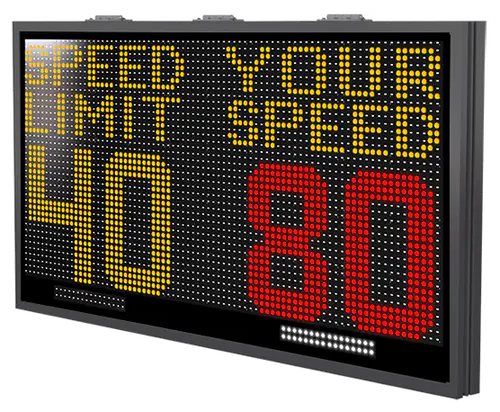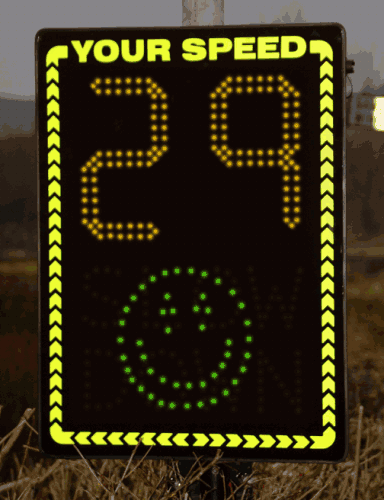Speed Limit Sign with Radar: How They Work and Why They Matter
In today’s fast-paced world, where time is often of the essence, the importance of adhering to speed limits cannot be overstated. Speed limit signs or radar speed signs equipped with radar technology, are indispensable in ensuring road safety and regulating traffic flow. However, the science behind these seemingly straightforward signs is far more complex than meets the eye. In this in-depth exploration, we delve into the intricacies of speed limit signs with radar, unraveling their inner workings and elucidating their profound significance in modern transportation systems.
Table of Contents
Understanding the Basics: What Are Speed Limit Sign with Radar?
Speed limit signs with radar, commonly referred to as radar speed signs or radar speed displays, are sophisticated devices engineered to monitor and display the speed of approaching vehicles. At their core, these signs consist of three primary components: a radar sensor, a display unit, and often supplementary features such as data logging capabilities or wireless connectivity.
The radar sensor, typically mounted on or near the speed limit sign, emits radio waves in a specific direction, usually targeting oncoming traffic. As vehicles enter the radar’s detection zone, the emitted radio waves reflect off them and return to the sensor. This phenomenon, known as the Doppler effect, causes a shift in the frequency of the returning waves proportional to the speed of the vehicle relative to the sign’s location.
Upon receiving the reflected waves, the radar sensor calculates the speed of the vehicle based on the frequency shift, employing sophisticated algorithms to ensure accuracy and reliability. Subsequently, this speed data is transmitted to the display unit, where it is presented to the driver in a highly visible format, typically through an LED display showcasing the vehicle’s speed.

How Do They Work?
To grasp the intricacies of speed limit signs with radar, it’s essential to delve into their operational mechanisms:
Radar Emission: The radar sensor emits radio waves with a specific frequency and wavelength, directed towards the flow of traffic.
Reflection and Doppler Effect: As vehicles pass through the radar’s detection zone, the emitted radio waves interact with them and bounce back towards the sensor. The Doppler effect causes a change in the frequency of the returning waves, which is directly proportional to the speed of the vehicle relative to the sign’s location.
Speed Calculation: Leveraging the frequency shift caused by the Doppler effect, the radar sensor employs advanced signal processing algorithms to precisely calculate the approaching vehicle’s speed.
Display: The calculated speed is then relayed to the display unit, where it is presented to the driver in a clear and easily readable format. The LED display typically showcases the vehicle’s speed in large digits, ensuring maximum visibility and comprehension.
Feedback Loop: By providing real-time feedback to drivers regarding their speed, radar speed signs serve as proactive measures to encourage adherence to posted speed limits and promote safer driving habits.

Why Do They Matter?
The significance of speed limit sign with radar transcends mere speed monitoring, encompassing a myriad of crucial aspects:
Enhancing Road Safety: One of the primary objectives of radar speed signs is to bolster road safety by alerting drivers to their speed and encouraging them to adjust their driving behavior accordingly. By fostering increased awareness and vigilance, these signs help mitigate the risk of accidents and save lives on our roadways.
Traffic Management and Calming: In areas plagued by speeding vehicles or recurring traffic accidents, radar speed signs play a pivotal role in traffic management and calming efforts. By reminding drivers to adhere to posted speed limits, these signs contribute to the creation of safer and more orderly traffic conditions, reducing congestion and enhancing overall efficiency.
Data Collection and Analysis: Many radar speed signs are equipped with sophisticated data logging capabilities, enabling transportation authorities to gather valuable insights into traffic patterns and trends. By analyzing this data, authorities can identify high-risk areas, formulate targeted interventions, and implement evidence-based strategies to improve road safety and optimize traffic flow.
Cost-Effective Solutions: Compared to traditional enforcement methods such as speed cameras or police patrols, radar speed signs offer a cost-effective means of promoting compliance with speed limits. Their relatively low maintenance requirements and versatility make them an attractive option for municipalities and transportation agencies seeking to maximize their resources while effectively managing traffic safety.
Community Engagement and Awareness: Radar speed signs serve as visible reminders to residents and motorists of the importance of responsible driving practices. By fostering community engagement and awareness, these signs contribute to the cultivation of a culture of mutual respect and cooperation on our roadways, ultimately leading to safer and more harmonious communities.

Real-World Applications and Case Studies:
The practical applications of speed limit sign with radar are diverse and far-reaching, spanning a wide range of settings and scenarios:
School Zones: Radar speed signs are frequently deployed in school zones to safeguard the well-being of children and pedestrians. By alerting drivers to reduce their speed, these signs create a safer environment around schools, preventing accidents and ensuring the safety of vulnerable road users.
Residential Neighborhoods: In residential areas where speeding vehicles pose a persistent threat to community safety, radar speed signs serve as effective deterrents against reckless driving behavior. By reminding drivers to slow down and exercise caution, these signs help foster a sense of security and tranquility within neighborhoods, enhancing residents’ quality of life.
Work Zones and Construction Areas: Construction zones and road work areas are inherently hazardous environments, requiring heightened vigilance and caution from drivers. Radar speed signs can be instrumental in promoting safe driving practices within these zones, reducing the risk of accidents, and ensuring the safety of both workers and motorists navigating these areas.
Highways and Freeways: Even on highways and freeways, where speeds are typically higher and traffic volumes are elevated, radar speed signs play a vital role in promoting adherence to posted speed limits and fostering safer driving habits among motorists. By alerting drivers to their speed and encouraging compliance with speed regulations, these signs contribute to preventing accidents and reducing traffic congestion on major thoroughfares.
Conclusion:
In conclusion, speed limit sign with radar represent a sophisticated and effective means of promoting road safety, regulating traffic flow, and enhancing the overall quality of our transportation systems. Through their advanced technology and proactive approach to speed management, these signs serve as invaluable tools in our ongoing efforts to create safer, more efficient, and more sustainable roadways for all users. As we continue to innovate and evolve in the realm of traffic safety and management, speed limit sign with radar will undoubtedly remain at the forefront of our endeavors, guiding us toward a future where road safety is paramount, and accidents are minimized.

